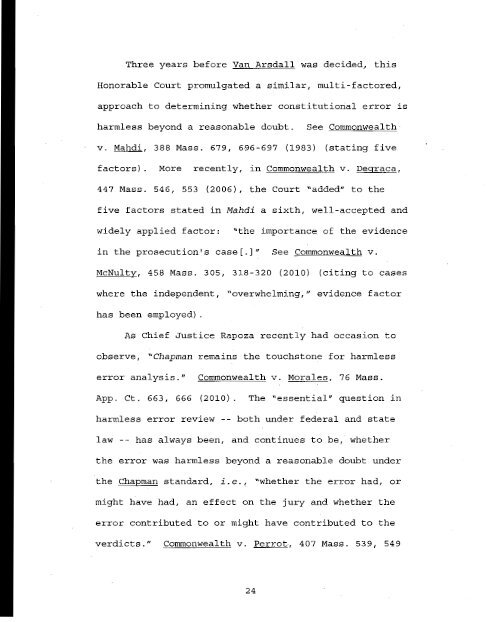463 Mass. 353 - Appellee Commonwealth Brief - Mass Cases
463 Mass. 353 - Appellee Commonwealth Brief - Mass Cases 463 Mass. 353 - Appellee Commonwealth Brief - Mass Cases
Three years before Van Arsdall was decided, this Honorable Court promulgated a similar, multi-factored, approach to determining whether constitutional error is harmless beyond a reasonable doubt. See Commonwealth v. Mahdi, 388 Mass. 679, 696-697 (1983) (stating five factors). More recently, in Commonwealth v. Degraca, 447 Mass. 546, 553 (2006), the Court "added" to the five factors stated in Mahdi a sixth, well-accepted and widely applied factor: "the importance of the evidence in the prosecution's case[.]" See Commonwealth v. McNulty, 458 Mass. 305, 318-320 (2010) (citing to cases where the independent, "overwhelming," evidence factor has been employed) . As Chief Justice Rapoza recently had occasion to observe, "Chapman remains the touchstone for harmless error analysis." Commonwealth v. Morales, 76 Mass. App. Ct. 663, 666 (2010). The "essential" question in harmless error review -- both under federal and state law -- has always been, and continues to be, whether the error was harmless beyond a reasonable doubt under the Chapman standard, i.e., "whether the error had, or might have had, an effect on the jury and whether the error contributed to or might have contributed to the verdicts." Commonwealth v. Perrot, 407 Mass. 539, 549 24
- Page 1 and 2: COMMONWEALTH OF .MASSACHUSETTS SUPR
- Page 3 and 4: B. Applying the Degraca/Mahdi Facto
- Page 5 and 6: Cases Commonwealth v. Degraca, 447
- Page 7 and 8: Cases Commonwealth v. Todisco, 363
- Page 9 and 10: COMMONWEALTH OF MASSACHUSETTS SUPRE
- Page 11 and 12: The defendants moved to suppress ev
- Page 13: in a primarily residential neighbor
- Page 17: informants are used in drug investi
- Page 20 and 21: (an eighth of an·ounce of cocaine)
- Page 23: etween the defendants' drug dealing
- Page 26 and 27: 431 (1992), or the informant has pr
- Page 28 and 29: Blake, 413 Mass. 823, 828 (1992). N
- Page 31: Fifth Amendment violation can be ha
- Page 35 and 36: medical examiner, the "premise of t
- Page 37 and 38: findings of guilty." Vasquez, 456 M
- Page 39 and 40: Ronald Mendes is in error when he c
- Page 42 and 43: in the case of a violation of a def
- Page 44 and 45: 767 (2005), where the defendant's d
- Page 46: of the Commonwealth's case and were
- Page 50 and 51: He acknowledged "the cocaine that w
- Page 52 and 53: marijuana, as admitted by the defen
- Page 54 and 55: A. Detective Hyde's Testimony Conce
- Page 56 and 57: G. L. c. 272, § 99(B) (4). Detecti
- Page 58: cellular telephone during booking w
Three years before Van Arsdall was decided, this<br />
Honorable Court promulgated a similar, multi-factored,<br />
approach to determining whether constitutional error is<br />
harmless beyond a reasonable doubt. See <strong>Commonwealth</strong><br />
v. Mahdi, 388 <strong>Mass</strong>. 679, 696-697 (1983) (stating five<br />
factors). More recently, in <strong>Commonwealth</strong> v. Degraca,<br />
447 <strong>Mass</strong>. 546, 553 (2006), the Court "added" to the<br />
five factors stated in Mahdi a sixth, well-accepted and<br />
widely applied factor: "the importance of the evidence<br />
in the prosecution's case[.]" See <strong>Commonwealth</strong> v.<br />
McNulty, 458 <strong>Mass</strong>. 305, 318-320 (2010) (citing to cases<br />
where the independent, "overwhelming," evidence factor<br />
has been employed) .<br />
As Chief Justice Rapoza recently had occasion to<br />
observe, "Chapman remains the touchstone for harmless<br />
error analysis." <strong>Commonwealth</strong> v. Morales, 76 <strong>Mass</strong>.<br />
App. Ct. 663, 666 (2010). The "essential" question in<br />
harmless error review -- both under federal and state<br />
law -- has always been, and continues to be, whether<br />
the error was harmless beyond a reasonable doubt under<br />
the Chapman standard, i.e., "whether the error had, or<br />
might have had, an effect on the jury and whether the<br />
error contributed to or might have contributed to the<br />
verdicts." <strong>Commonwealth</strong> v. Perrot, 407 <strong>Mass</strong>. 539, 549<br />
24



